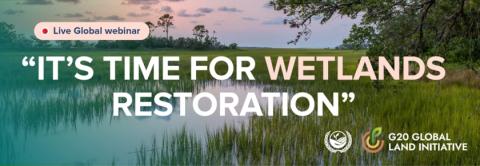Statement by Elizabeth Maruma Mrema Executive Secretary of the Convention on Biological Diversity on the occasion of World Wetlands Day 2 February 2023
sp-2023-02-02-wetland-en.pdfWater. For too long this precious, life-giving resource has been taken for granted in so many places. In some parts of the world, it is easy to turn on a faucet and give no thought or consideration to where the water is coming from and who still lacks access to it. This cannot continue.
Wetlands provide vital ecosystem functions and services, including improving water quality and availability. Thus, they are critically important for peoples’ health, livelihoods and wellbeing. Beyond water quality, wetlands provide fish and wildlife habitats, store floodwaters, harbour biodiversity, and so much more.
Sadly, 35% of the world’s wetlands have disappeared over the last 50 years.1 The global drivers of wetland degradation are the same main drivers of biodiversity loss worldwide:
• land-use change, including the draining of wetlands for other land-use purposes,
• pollution,
• invasive alien species,
• unsustainable use and direct exploitation of natural resources, and
• climate change.2,3
Restoring wetland ecosystems addresses sustainable development from all angles and produces multiple benefits by provisioning food and water security, conserving biodiversity, increasing resilience, combatting climate change, and reducing risk of disaster.
Here and now, in the UN Decade on Ecosystem Restoration, more needs to be done to protect and restore these critical ecosystems. We must promote sustainable water management policies and practices that address the drivers of wetland degradation to improve water quality, reduce pollution, prevent and manage invasive alien species, sustainably use freshwater species and safeguard connectivity of freshwater systems.
This decade we must accelerate action to protect, conserve and make sustainable use of wetlands for both people and nature. With the newly adopted Kunming-Montreal Global Biodiversity Framework as our roadmap, it is time to implement the Framework and act for wetlands.
The protection and restoration of wetlands is most evident in targets 2 and 3 of the new Framework, which aim to reduce threats to biodiversity by 2030, by:
• ensuring at least 30 per cent of areas of degraded inland water and coastal ecosystems are under effective restoration; and
• ensuring at least 30 per cent of inland water and coastal areas are effectively conserved and managed through protected areas and other effective area-based conservation measures.
Other targets within the Framework focus on meeting the needs of people through sustainable use, such as Target 11, which aims to measure the regulation of water-based ecosystem functions and services, including water quality, stress, and sanitation.
The Secretariat of the Convention on Biological Diversity appreciates the ongoing work of other biodiversity-related conventions, particularly the Ramsar Convention on Wetlands, and will continue to enhance collaboration for more efficient and effective implementation. I encourage everyone to urgently act for wetlands – educate yourselves, make water-friendly decisions, and consider where the water from the faucet originated.
After all, as Leonardo da Vinci once said, “Water is the driving force of all nature.”

